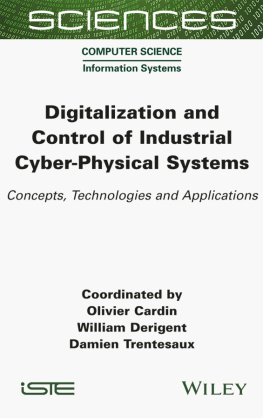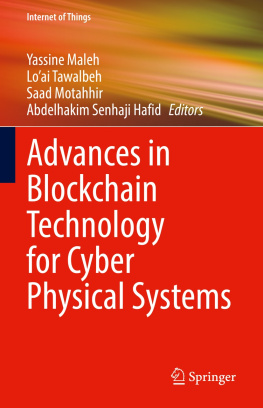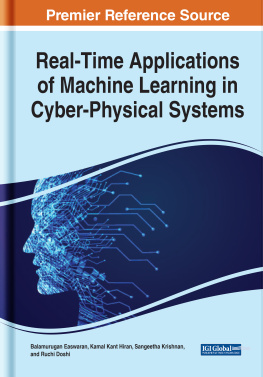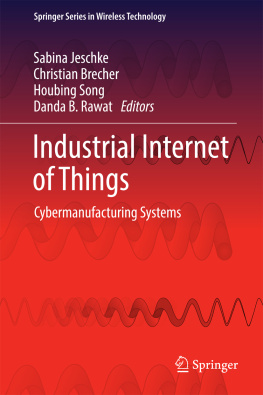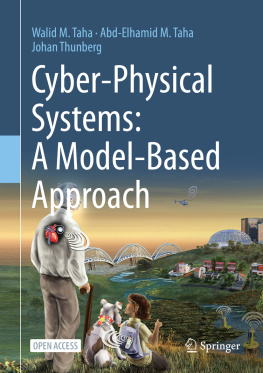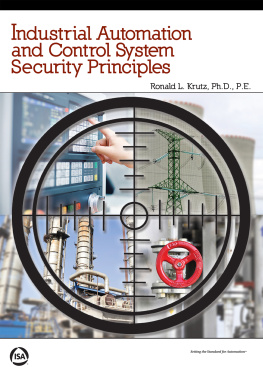
SCIENCES
Computer Science, Field Directors
Valrie Berth and Jean-Charles Pomerol
Information Systems, Subject Heads Florence Sdes,
Camille Rosenthal-Sabroux and Damien Trentesaux
Digitalization and Control of Industrial Cyber-Physical Systems
Concepts, Technologies and Applications
Coordinated by
Olivier Cardin
William Derigent
Damien Trentesaux

First published 2022 in Great Britain and the United States by ISTE Ltd and John Wiley & Sons, Inc.
Apart from any fair dealing for the purposes of research or private study, or criticism or review, as permitted under the Copyright, Designs and Patents Act 1988, this publication may only be reproduced, stored or transmitted, in any form or by any means, with the prior permission in writing of the publishers, or in the case of reprographic reproduction in accordance with the terms and licenses issued by the CLA. Enquiries concerning reproduction outside these terms should be sent to the publishers at the under mentioned address:
ISTE Ltd
27-37 St Georges Road
London SW19 4EU
UK
www.iste.co.uk
John Wiley & Sons, Inc.
111 River Street
Hoboken, NJ 07030
USA
www.wiley.com
ISTE Ltd 2022
The rights of Olivier Cardin, William Derigent and Damien Trentesaux to be identified as the authors of this work have been asserted by them in accordance with the Copyright, Designs and Patents Act 1988.
Any opinions, findings, and conclusions or recommendations expressed in this material are those of the author(s), contributor(s) or editor(s) and do not necessarily reflect the views of ISTE Group.
Library of Congress Control Number: 2022931036
British Library Cataloguing-in-Publication Data
A CIP record for this book is available from the British Library
ISBN 978-1-78945-085-9
ERC code:
PE6 Computer Science and Informatics
PE6_2 Computer systems, parallel/distributed systems, sensor networks, embedded systems, cyber-physical systems
PE6_9 Human computer interaction and interface, visualisation and natural language processing
Foreword
Andr THOMAS
Retired
History has shown that the development of knowledge and science is not at all linear. These last decades have seen many scientists questioning ideas that are accepted by all (as Galileo had already done). Some physicists (including a Nobel Prize winner), where living beings, natural elements, and communicating and smart devices will live in harmony and, moreover, they will still be, I am convinced, called into question and redesigned when our community has assimilated all of the fundamentals of modern physics and its applications more fully.
It is commonly accepted that in order to project oneself into the future, it is necessary, on the one hand, to rely on and understand ones past and its evolution, and on the other hand, to adopt innovative approaches that leave room for evolution and breakthroughs. Let us quickly outline their main features.
The past: after more than a century of industry, we went from intelligence in the head and hands of the craftsman to (to caricature) intelligence in the head in offices and the specialized hands of operators, then finally to the intelligence in the head in computers and the hands of human beings and cyber-physical objects (robots, cobots, etc.) for the same objective of providing customers with quality products at controlled costs and deadlines. The idea was and remains good, but its first implementation in huge industries crowded with players was less so. The big change came in the 1980s after the discovery that finally, and no matter what was done, problems appeared all along the flow of components and products, so it was necessary to follow it more closely in order to make decisions and thus bring intelligence to it. The first solution was obviously the human being as an actor of this decentralized intelligence. If we only look at the future of our industries (and not life in general), we can see that many attempts have been made to develop functional specifications for such systems. What are we trying to do in the end? What is the ideal functioning of a company? Let us go back to the question posed by Goldratt and Cox was unfortunate and yet many so-called visionaries of that time assured that the future would be made of factories without humans. There have been such factories I myself have had the opportunity to visit them but they quickly showed their limits! As always in these cases of extreme rationalization, these solutions have proven themselves only in a stabilized and ideal mode of operation; any malfunction or any degraded mode induced big problems and additional costs, which finally killed the dream. Today, we are asking ourselves many more questions about the future of human actors in these new cyber-x societies and industries: what will be their roles, what are the underlying ethical problems (even if, to date, the existing studies on these subjects are limited, or rather only refer to our Western way of thinking).
There are two paths to innovation: evolutionary innovation, a more or less coherent extension of the path taken from the past to the present, and disruptive innovation, which must certainly be based on the weaknesses and shortcomings of existing solutions, but which starts from scratch to propose new functionally reasonable approaches and tools.
People who invent by means of a technological or conceptual leap in a field unknown to them are rare. During all of these years of transition, computer science was still poorly known; so, it was the evolution and especially the speed of evolution of computer systems that regulated the development of solutions for the modernization of life and industries in particular. The innovations of automatic and computer systems in the industry have followed those of electronic technologies and algorithms, and it is often step by step and by trial and error that these innovations have seen the light of day (let us keep in mind, for example, the case of the Minitel).
However, some innovations have been very significant and have allowed considerable leaps forward. Let us mention, of course, the Internet (who remembers today what TRANSPAC was?). Let us also mention the RFID type systems and especially their miniaturization. Note that these two examples of innovation are related to the field of communication. Making more use of field data, distributing intelligence as close as possible to where it is useful (in time and space) can only be envisaged by new generation communication systems, wireless of course, in real time and with high data rates.
Sophisticated methods have therefore emerged and been developed to help and support these innovation processes. The most important ones in the last decades have undoubtedly been the approaches of value management and systems engineering.
This book shows the evolution, describes the point of view of researchers and finally sets the scene for the current ICPS, without focusing on the inherent technology and its developments. It shows us the future of our industries and the various innovations that have been, are being and will be made in the near future. It first introduces us to the concept of cyber-physical systems from a historical perspective on the evolution of our society and industries. The question to be debated is why does our society need it? Various answers come to mind, such as the increase in the speed of execution of the activities and the necessary decision-making, or the increase in the dimension of the systems, as well as their complexity, or the increase in the globalization of the problems, etc.; and finally the will to leave human beings as important actors; then, to describe this crucial field that is the data; how to capture and distribute field information. Indeed, without recent and relevant data, no analysis, measurement, modeling or decision can be envisaged. It will then deal with the evolution of smart products, the digitalization of information and these systems. Then, the equally crucial problem of their piloting, control and interaction (or integration) with humans. The very essence of intelligence shared with the part relating to their learning; the current artificial intelligence solutions are based on two pillars, which are learning and algorithms. Their potential contributions to our companies and logistic systems, as well as their probable future and evolutions will also be looked at. The last parts of this book deal with the consequences and impacts of such systems on the industry, as well as the ethical and legal issues and aspects related to ICPS. This book is structured into chapters and sections, which are described in .
Next page
